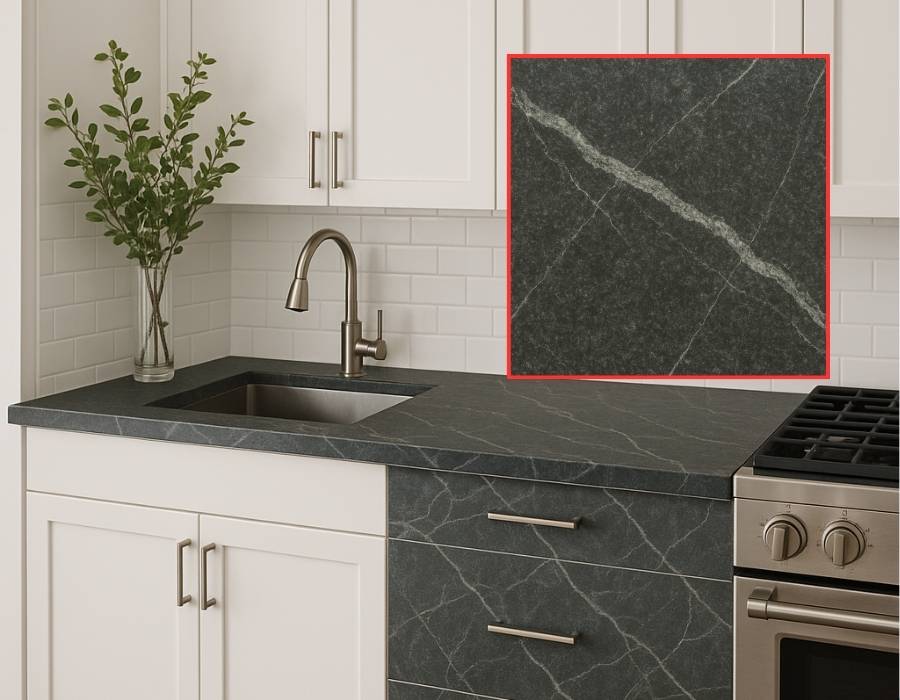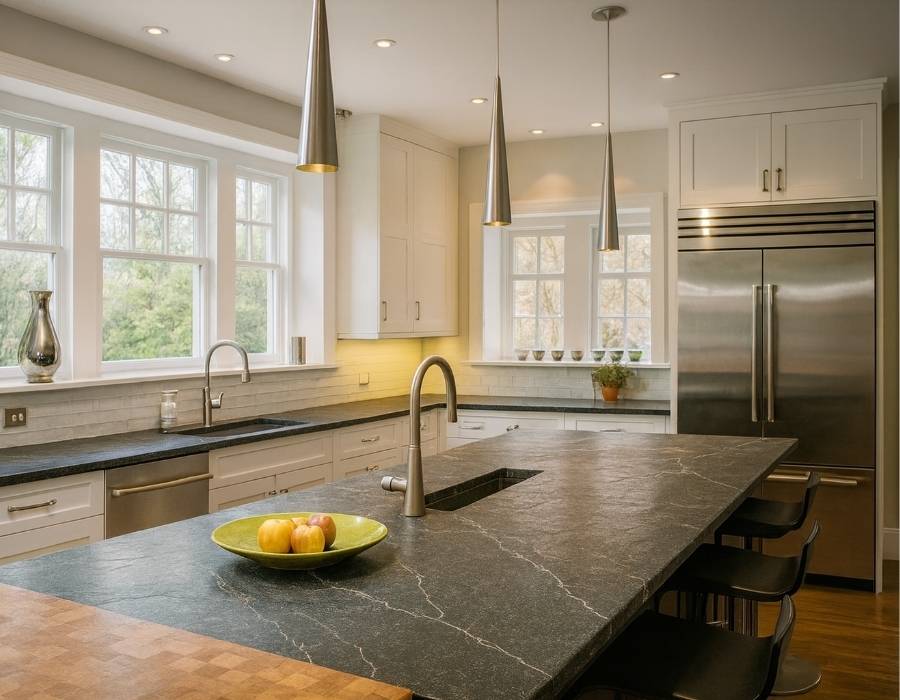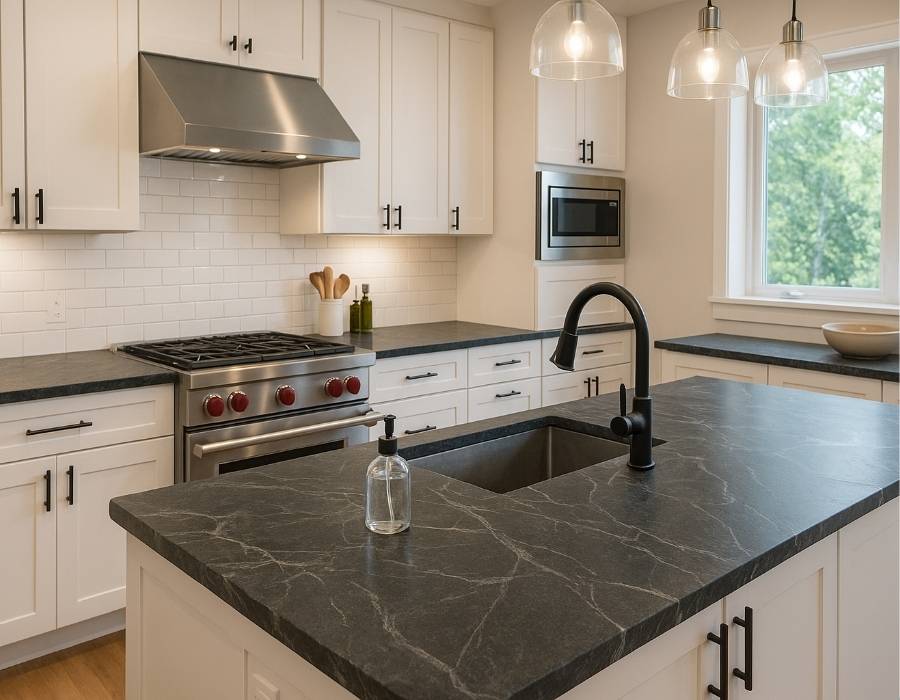Soapstone Countertops: Old-World Stone With Modern Appeal
The Overlooked Classic
Every few years a new “must-have” surface takes over the design world. Granite had its heyday. Quartz still dominates showroom floors. Marble remains forever aspirational. But running quietly in the background, like a timeless old friend, is soapstone.
It’s not flashy, but it has history. Not trendy, but enduring. And in a world where kitchens double as both family hubs and showpieces, soapstone deserves another look. This dense, heat-resistant, naturally beautiful stone isn’t just an alternative to the usual suspects—it’s a category of its own.
A Stone With Centuries of Service
If soapstone could talk, it would speak in many languages. Vikings carved cooking vessels and grave markers from it. Native Americans shaped bowls and ceremonial pieces. Arctic peoples relied on it for warmth, carving lamps and hearths because of its incredible ability to absorb and radiate heat. Even today, you’ll find soapstone framing fireplaces for the same reason: few stones handle heat so gracefully.
That pedigree sets soapstone apart. It’s not just decorative—it’s battle-tested. This is a stone that has spent centuries in fire and still come out looking beautiful.
What Exactly Is Soapstone?

Soapstone, or steatite, is a metamorphic rock made primarily of talc, with varying amounts of chlorite, magnesite, and mica. That high talc content gives it the “soapy” feel that inspired its name.
Architects and designers distinguish between two main types:
- Artistic soapstone: high in talc, soft, ideal for carving.
- Architectural soapstone: denser, harder, and used for countertops, sinks, and fireplaces.
Quarried around the globe—from Brazil and India to Vermont and Virginia—each source has its own signature look. Some slabs lean toward cool gray, others pull green or blue. A few varieties even darken to nearly black when oiled, with dramatic white veining running across the surface like frozen rivers.
Why Soapstone Wins in Daily Life
So why choose soapstone over granite, quartz, or marble? A handful of qualities make it stand out:
It’s Naturally Non-Porous
Unlike marble or granite, soapstone won’t soak up wine, oil, or tomato sauce. Spill, wipe, done. No annual sealing required, ever.
It’s Sanitary
That non-porous quality also means bacteria can’t burrow in. Soapstone stays cleaner and more hygienic with less effort—something every busy kitchen needs.
It Laughs at Heat
Slide a pot straight from the burner to the counter without a trivet. Soapstone won’t scorch, crack, or wince. In fact, it holds heat so well it’s often used in wood stoves and pizza ovens.
It Resists Stains and Acids
Wine, vinegar, lemon juice—substances that etch marble barely register on soapstone. It’s chemically inert, so it shrugs off spills that would leave other surfaces permanently scarred.
It Ages Gracefully
Over time, soapstone develops a soft patina. Instead of looking worn out, it takes on a leathery, lived-in character that many homeowners find charming. For those who prefer a more uniform look, a little mineral oil keeps the color even and deep.
It’s Forgiving and Repairable
Yes, soapstone can scratch. But here’s the twist: those scratches can be buffed out with sandpaper and a dab of mineral oil. Unlike brittle quartz or granite, which can chip or crack permanently, soapstone can be restored in minutes.
It Lasts for Generations
Dense, durable, and resilient, a soapstone countertop—if cared for—will outlast the cabinetry beneath it. That makes it not just a design choice, but a long-term investment.
What to Consider Before Choosing Soapstone
No material is perfect. Soapstone does come with quirks that may not suit everyone.
- It scratches more easily than granite or quartz. Those who prefer a pristine, glossy surface may find its evolving character frustrating.
- It requires oiling—especially during the first year, until the stone saturates. It’s not hard, but it’s a ritual you need to accept.
- Patina develops unevenly. High-traffic areas darken faster, which means you’ll either embrace the contrast or commit to regular maintenance.
- Seams are visible, since each slab is unique.
- It’s not cheap. Soapstone can rival or exceed granite, quartz, and marble, depending on the variety.
For some, those are dealbreakers. For others, they’re part of the appeal—evidence that the material is natural, not manufactured.
Choosing the Right Slab
Soapstone comes in a spectrum of grays, greens, and even blues, often with striking white veining. Names like Barroca, Churchill, or Santa Rita may pop up from suppliers, but remember: these aren’t standardized. The only way to choose is to stand in front of actual slabs at a local fabricator and see which one speaks to you.
Unlike quartz, you can’t just order a sample and expect the finished product to match. Soapstone is more like wood—every piece has its own character.
Maintenance in Real Terms
Compared to marble or granite, soapstone is refreshingly low-maintenance. No sealing. No special cleaners. Windex, vinegar, even bleach won’t hurt it.
Scratches? Sand them. Dullness? Oil it. Soapstone doesn’t ask for much—just a little attention now and then. In return, it rewards you with decades of service and a surface that feels warmer, more tactile, more human than polished stone.
Why Soapstone Feels Different

What sets soapstone apart isn’t just durability or practicality. It’s the atmosphere it creates. Granite can feel cold. Quartz can feel manufactured. Marble can feel fragile. Soapstone feels… lived in. Comfortable. A surface that doesn’t just sit in your kitchen but becomes part of the life happening there.
It’s the countertop equivalent of a leather armchair: it shows its wear, but the wear makes it better.
The Bottom Line
Soapstone won’t be for everyone. If you want a glossy, untouchable surface, look elsewhere. But if you value durability, low maintenance, and a timeless look that softens and deepens with age, soapstone belongs at the top of your list.
It’s not the loudest voice in the room. But like all classics, it has staying power. In a world chasing trends, that might be exactly what your kitchen needs.

